|
 |
Fossils
Ginkgo a living fossil |
| . | Classification:
Kingdom Plantae -- Plants Subkingdom Tracheobionta -- Vascular plants Superdivision Spermatophyta -- Seed plants Division/phylum Ginkgophyta -- Ginkgo Class Ginkgoopsida Order Ginkgoales Family Ginkgoaceae -- Ginkgo family Genus Ginkgo L. The only living representative of the order Ginkgoales is the Ginkgo biloba. Source: National PLANTS Database -USDA, NRCS. 2001. The PLANTS Database, Version 3.1 |
. |
| The genus Ginkgo
is one of the major groups in the phylum Ginkgophytes. Fossils of Ginkgo
are recognized by its leaves, reproductive organs and wood. Its leaf remains
are the most often found.
Its earliest leaf fossils date
back to 270 million years ago in the Permian
period of the Paleozoic when seed ferns and ferns dominated and Ginkgo,
cycads and conifers came into prominence.
|
 Ginkgoales is a group of gymnosperms composed of the family Ginkgoaceae traditionally described as consisting of six “families” and possibly 19 genera, for instance Baiera, Ginkgoites, Ginkgoidium, Ginkgo, Arctobaiera, Sphenobaiera, Windwardia, Trichopitys. However this classification is ill-defined, for instance variations in Baiera, Sphenobaiera and Ginkgoites are now considered to be Ginkgo as well. Its maximum diversity was achieved
in the Jurassic and Early
Cretaceous periods of the Mesozoic. The pteridosperms (‘‘seed ferns’’),
and especially the Peltaspermales, are at present thought to be the most
plausible ancestral group.
|
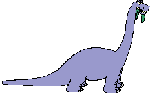 Undoubted
oldest fossils of the genus Ginkgo (Ginkgo digitata) are
from Undoubted
oldest fossils of the genus Ginkgo (Ginkgo digitata) are
from
the Early Jurassic period in the Mesozoic from a single location (Fergana) in what is now the Asiatic part of the former USSR, and therefore it is considered to be the oldest extant genus among seed plants. During this time Ginkgo, Bennettitales, ferns, cycads and conifers dominated the vegetation of the world. Mesozoic climate: no polar ice, wet and warm climatic conditions followed after aridity in the early Mesozoic. During the Middle Jurassic there was an increase in species, Ginkgo digitata, Ginkgo huttoni, Ginkgo yimaensis, throughout the northern parts of the Laurasian supercontinent. |
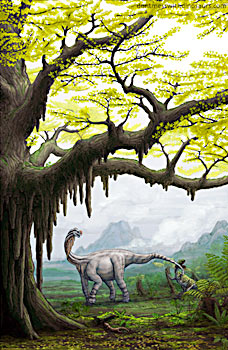
click to enlarge Middle Jurassic of China, Shunosaurus under a Ginkgo yimaensis with chichi © Brian Engh |
Maximum diversity in species
existed during the Cretaceous period in the
Northern
Hemisphere, areas now known as Asia, Europe and North America, for
instance Ginkgo coriacea, Ginkgo adiantoides, Ginkgo tigrensis, Ginkgo
apodes, Ginkgo digitata, Ginkgo yimaensis, Ginkgo gardneri. Ginkgo
was also present in the Southern Hemisphere:
Gondwana.
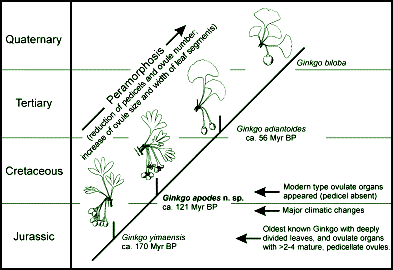
Ginkgo evolution (click to enlarge) From: Zhou Z, Zheng S , 2003
|
Most species are
mainly distinguishable on the basis of leaf anatomy and geographical distribution.
It is well known that leaves on a living Ginkgo tree have a considerable
variation in form, therefore the fossil record is supposed to include many
species close to Ginkgo biloba (thus certain species names are adopted
only as a matter of convenience).
However fossils of Ginkgo yimaensis (170 mya) and Ginkgo apodes (121 mya) are found with Ginkgo-like reproductive organs and these discoveries leave no doubt about their belonging to the genus Ginkgo. |
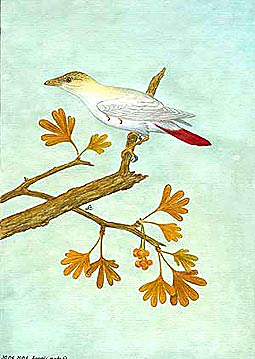 |
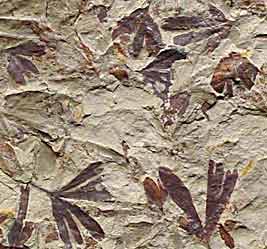
Ginkgo huttoni Middle Jurassic, Scalby, North Yorkshire, UK photo © David Scarboro |
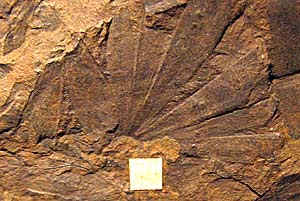
Ginkgo sibirica Late Jurassic, Oregon National Museum of Natural History, Washington D.C. photo © Nico Bal |
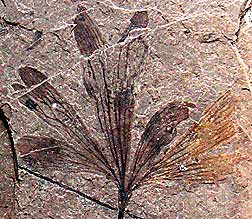
Ginkgo dissecta Eocene, MacAbee Formation, Cache Creek, British Columbia, Canada photo © David Scarboro |
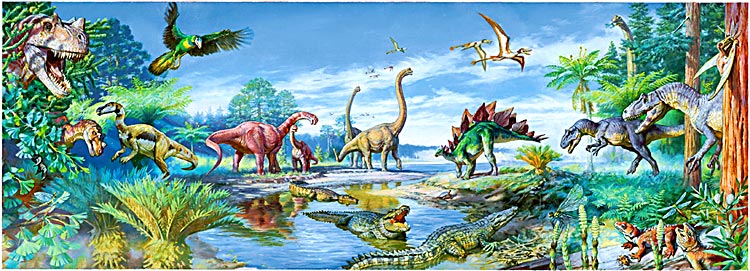
The World of Dinosaurs, Cretaceous landscape North America (left: Ginkgo tree) picture from The United States Postal Service In structure and form (morphologically)
indistinguishable forms of Ginkgo biloba extend back to the Early
Cretaceous, therefore many researchers consider the fossil and modern
forms to belong to the same species. This fossil form is most commonly
identified as Ginkgo adiantoides,
however many other designations are considered essentially equal.
|
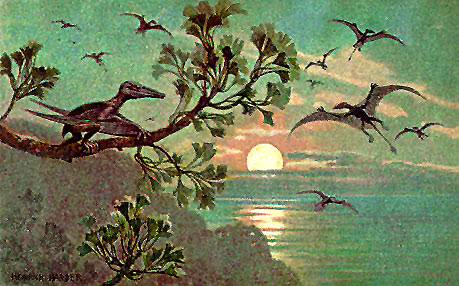 picture Heinrich Harder |
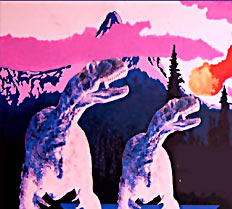 |
Only three (or four) species
were left in the
Tertiary (65 million years
ago): Ginkgo adiantoides (mainly Northern Hemisphere) with leaves
virtually indistinguishable from modern Ginkgo biloba, andGinkgo
gardneri (late Paleocene, only found on
the Isle of Mull, Scotland).
Ginkgo jiayinensis (Northeast
China, Wuyun Formation of Jiayin) differs from other Cenozoic ginkgos in
having amphistomatic leaves (stomata (pores) on both surfaces of
the leaf) due to environmental adaptation.
In the Southern Hemisphere a
different, more strongly digitate type of Ginkgo leaf persists into the
Eocene,
but so far it is not well documented (Ginkgo patagonica).
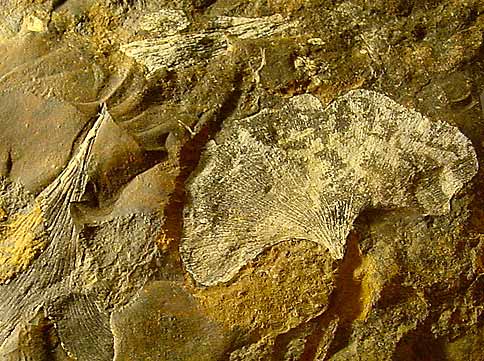
Ginkgo adiantoides, Paleocene, Scotland Naturalis, Leiden photo © Cor Kwant |
Video: Different shapes
of leaves on Ginkgo biloba.
|
The decline is possibly the result
of the extensive cooling that occurs throughout the Northern Hemisphere
and rainfall gradually shifting from one of the summer-wet to one of summer-dry.
The rise of the angiosperms might have played a role as well. The extinction
of the dinosaurs as potential seed dispersers of the large seeds
may also have influenced this decline, which is in line with the fossil
records. Read more about seed dispersers on my Propagation-page.
Climate of the
Cenozoic: very warm to glacial
period.
About 7 million years ago Ginkgo
disappeared from the fossil record of North America.
In Eurasia only very limited
numbers of fossils are found from the Pliocene,
and for the Pleistocene, the only known occurences
of Ginkgo are from southwestern Japan. It was gone from Europe by
about 2.5 million years ago.
Ginkgo biloba L. survived
in some areas of China where the impact of glaciation was minimal.
DNA analyses have demonstrated
(Zhao et al., 2019) that Ginkgo refugia occur in
southwestern, eastern and southern China:
- A refugium occurs in southwestern
China especially around the southern slopes
of Jinfo Mountain (Jinfo Shan) of Nanchuan County at the boundary
of Chongqing Municipality and Guizhou Province (see area map; 28°53'N;
107°27'E). Ecological work in this area, as well as in adjacent parts
of Guizhou Province, has identified numerous small populations, for instance
in Wuchuan County and Tuole (Panxian), that can be considered to be either
wild or remnants of wild plants. Evidence for the persistance of wild Ginkgo
biloba (Ginkgoaceae) populations in the valley and lower mountain slopes
of the Dalou mountains was published in 2012 (Tang
et al.) and in 2019 (Zhao et al.).
More info and photos here.
- Ginkgos in eastern
China, e.g. on West Tianmu
Mountain, Zhejiang province: this nature reserve is an another
refugium for wild Ginkgo biloba communities.
Non-Chinese populations are
all genetically close to this eastern lineage, indicating multiple human-mediated
introductions of Ginkgo from eastern China into North America and Europe.
More info: article Zhao et al.
- A third refugium has been genetically
classified in
southern China
e.g. in Fujian province.
Interesting is that nearly all
fossil finds of Ginkgo lie poleward of 40
oN
latitude, during the Tertiary more toward 40 o due to cooling
and increased seasonality. Its survival in China is deviating from the
long-term history of Ginkgo.
The Chinese Ginkgo biloba survived essentially unchanged. From the Jurassic till now there was a reduction of individual ovule-stalks and a decrease in the number of ovules. The size of the ovules increased. The ovulate organs may find their origin in the Middle JurassicGinkgo yimaensis (170 million years ago). The embryos of Ginkgo biloba seeds possess a temperature-dependent developmental-delay mechanism that allows seeds to survive winter by preventing premature germination in fall. This and other cold-climate adaptations appear to have evolved within the genus Ginkgo during the early Cretaceous, when the Northern Hemisphere was undergoing dramatic cooling after a long period of stable, warm conditions. Fossilized leaves and reproductive organs from the Lower Cretaceous period (Ginkgo apodes found in the 121 million years old Yixian Formation in N.E. China) show that their morphology has changed little until now.
Ginkgo adiantoides from
the Tertiary period (56 million years ago) is
remarkably similar to the modern Ginkgo biloba.
| Fossil
woods of the
Ginkgoales are rare. A well-known example is Ginkgo beckii named
after prof. George Beck, who discovered the petrified wood in the 1930s
near Columbia River Gorge, Vantage, central Washington, North America.
Dating from the Miocene period, 15 million-year-old petrified logs of Ginkgo beckii and many other tree species have been uncovered from flood sediments and lava flows near this region. Ginkgo logs were carried by raging flood waters to the vantage area, where they lay burried in lake bed sediments covered by lava flows for millions of years. Ginkgo beckii shows a striking similarity to Ginkgo biloba wood, with the possible exception of fewer pits per unit length on the radial walls of its tracheids.
In 2016 fossil wood -Ginkgoxylon
liaoningense- was collected from the Tiaojishan Formation in western
Liaoning, northeastern China.
|
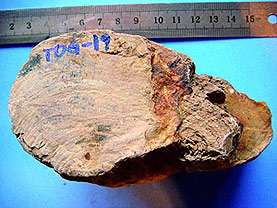
Ginkgoxylon liaoningense
Believed to be fossil wood is
known from the Lower Permian (Hueco Formation,
New Mexico) and Late Triassic (Holbrook
area, Chinle Formation, Petrified Forest National Park, Arizona).
petrified
Ginkgo
wood, 17 cm diam., Miocene
Fossil ginkgoalean wood is probably scarce because of lack of chemical resistance of the wood to degradation of the cell walls after deposition in sediments. More photos and info about Ginkgo wood. |
| Life history traits of the genus
Ginkgo
are for instance:
- highly conservative morphologically - slow space of evolution - slow reproduction rate (late sexual maturity) - large seeds - long life span - conservative in its ecological tolerance: well-drained disturbed habitats; now representing an ecological paradox because the living Ginkgo biloba L. has few of the life-history traits typical for plants that prosper in modern disturbed settings. But it now also thrives in for instance New York City Center, it does not suffer from air pollution and pests! video CreatureCast
|
|
|
|
|
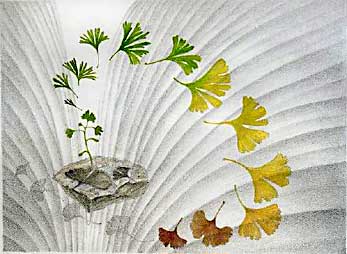
Spuren picture © Atsuko Kato |
|
||||
:
Literature:
-Brenner
ED, Katari MS, Stevenson DW, Rudd SA, Douglas AW, Moss WN, Twigg RW, Runko
SJ, Stellari GM, Richard MW, Coruzzi GM. 2005. EST analysis in
Ginkgo biloba: an assessment of conserved developmental regulators and
gymnosperm specific genes. BMC Genomics. 6(1):143.
-Brenner
ED, Stevenson DW, Twigg RW. 2003. Cycads: evolutionary innovations and
the role of plant-derived neurotoxins. Trends Plant Sci.;8(9):446-52.
-Chen
L. Q., Li C. S., Chaloner W. G., Beerling D. J., Sun Q. G., Collinson M.
E. & Mitchell P. L. 2001. Assessing the potential for the stomatal
characters of extant and fossil Ginkgo leaves to signal atmospheric CO2
change. American Journal of Botany 88 (7): 1309-1315.
-Chung-Shien
Wu, et al. Chloroplast Phylogenomics Indicates that Ginkgo biloba Is
Sister to Cycads. Genome Biol Evol (2013) 5 (1): 243-254. doi:
10.1093/gbe/evt001.
-Del Tredici,
P., H. Ling, and G. Yang. 1992. The Ginkgos of Tian Mu Shan. Conservation
Biology 6:202–209.
-Del Tredici,
P. 2000. Ginkgo biloba, in Ginkgo Biloba part 12 in the series
Medical and Aromatic Plants, Van Beek T - Industrial Profiles,
Harwood Academic Publ., Amsterdam.
-Del Tredici,
P. 2007. The Phenology of Sexual Reproduction in Ginkgo biloba: Ecological
and Evolutionary Implications. The Botanical Review: Vol. 73, No. 4,
pp. 267–278.
-Deng Shenghui,
Yang Xiaoju & Zhou Zhiyan. 2004. An Early Cretaceous Ginkgo ovule-bearing
organ fossil from Liaoning, Northeast China and its evolutionary implications.
Chinese
Science Bulletin Vol. 49 No. 16 1774—1776.
-Gee, Carole
T. et al. 2010. Plants in Mesozoic Time: Morphological Innovations,
Phylogeny, Ecosystems. Indiana University Press, Indianopolis.
-Hohmann,
N. et al. 2018. Ginkgo biloba's footprint of dynamic Pleistocene history
dates back only 390,000 years ago. BMC Genomics, 2018 Apr 27;19(1):299.
doi: 10.1186/s12864-018-4673-2.
-Hori,
T., R. W. Ridge, W. Tulecke, P. Del Tredici, J. Trémouillaux-Guiller,
and H. Tobe, eds. 1997. Ginkgo biloba:a global treasure. Springer,
Tokyo.
-Jiang,
Z. et al. A Jurassic wood providing insights into the earliest step
in Ginkgo wood evolution. Scientific Reports 6, art.no. 38191, Nov./December
2016.
-Kwant
C. 2006. The Ginkgo Pages, History/Tree/Propagation-pages. Internet
website.
- Ludwig-Maximilians-Universität
München. 1998. Der Ginkgo - Baum, ein Unikum mit Vergangenheit.
Internet
website.
-Mustoe
George E. 2002. Eocene Ginkgo leaf fossils from the Pacific Northwest.
Can. J. Bot. 80(10): 1078–1087.
-Li, H.-L.
1956. A horticultural and botanical history of Ginkgo. Morris Arboretum
Bulletin 7:3–12.
- Nagalingum,
N.S., Marshall C.R., Quental T.B., Rai H.S., Little D.P., Mathews S. 2011.
Recent
Synchronous Radiation of a Living Fossil. Science, DOI: 10.1126/science.1209926.
-Quan C,
Sun G, Zhou Z. 2010. A new Tertiary Ginkgo (Ginkgoaceae) from the Wuyun
Formation of Jiayin, Heilongjiang, northeastern China and its paleoenvironmental
implications. American Journal of Botany 97 (3): 1-12. (doi:10.3732/ajb.0900128)
-Rothwell,
G. W., Holt, B. 1997. Fossils and phenology in the evolution of Ginkgo
biloba, in Ginkgo biloba--a Global Treasure from Biology to Medicine
(eds. Hori, T., Ridge, R. W., Tulecke, W. et al.), Tokyo: Springer Verlag,
223-230.
-Royal
Botanic Gardens Sydney. 2004. The Cycad Pages. Internet
website.
-Royer,
Dana L, Hickey, Leo J. and Wing, Scott L. 2003. Ecological conservatism
in the ‘‘living fossil’’ Ginkgo. Paleobiology, 29(1), pp. 84–104.
-Savidge,
R. A., 2006. Xylotomic evidence for two new conifers and a ginkgo within
the Late Triassic Chinle Formation of Petrified Forest National Park, Arizona.
Museum of Northern Arizona Bulletin 62:147-149.
-Scott,
R. A., E. S. Barghoorn, and U. Prakash. 1962. Wood of Ginkgo in the
Tertiary of western North America. American Journal of Botany, Vol.
49, No. 10, pp. 1095-1101.
-Seward,
A. C. 1919. Fossil plants. IV. Ginkgoales, Coniferales, Gnetales. Cambridge
University Press, Cambridge.
-Shen,
L., X. Y. Chen, X. Zhang, Y. Y. Li, C. X. Fu & Y. X. Qiu. 2005. Genetic
variation of Ginkgo biloba L. (Ginkgoaceae) based on cpDNA PCR_Rflps: inference
of glacial refugia. Heredity 94, pp. 396–401.
-Stewart,
W. N. 1983. Paleobotany and the evolution of plants. Cambridge University
Press, Cambridge.
-Stewart,
W. N., Rothwell, G. W.. 1993. The record of a living fossil: Ginkgo,
in Paleobotany and the Evolution of Plants (eds. Stewart, W. N., Rothwell,
G. W.), London: Cambridge University Press, 385—412.
- Tang,
Cindy Q et al. 2012. Evidence for the persistence of wild Ginkgo biloba
(Ginkgoaceae) populations in the Dalou Mountains, southwestern China. Am.
J. Bot. August 2012, 99:1408-1414.
- Tidwell,
W.D. and Munzing, G.E., 1995. Gymnospermous woods from the Lower Permian
Hueco Formation of south-central New Mexico. New Mexico Museum of Natural
History and Science Bulletin, 6:91-100.
-Tralau,
H. 1967. The phytogeographic evolution of the genus Ginkgo L. Botaniska
Notiser 120:409–422.
-Tralau,
H. 1968. Evolutionary trends in the genus Ginkgo. Lethaia 1:63–101.
-Uemura,
K. 1997. Cenozoic history of Ginkgo in east Asia. Pp. 207–221 in
Hori et al. 1997.
-University
of California Museum of Paleontology. 2006. Ginkgoales. Internet
website.
-University
of Chicago. The Paleogeographic Atlas Project. 2001. The Paleogeographic
Atlas Project. Internet
website.
-Wei Gong,
Zhen Zeng, Ye-Ye Chen, Chuan Chen, Ying-Xiong Qiu and Cheng-Xin Fu. 2008.
Glacial
refugia of Ginkgo biloba L and human impact on its genetic diversity: evidence
from chloroplast DNA. J. Integr. Pl. Biol. 50 (3), pp. 368-374.
- Zhao,
Yun-Peng et al. Resequencing 545 ginkgo genomes across the world reveals
the evolutionary history of the living fossil. Nature Communications
10, art.4201, 2019.
- Zheng,
S. -L., Zhou, Z. -Y. 2004. A new Mesozoic Ginkgo from western Liaoning,
China and its evolutionary significance, Rev. Palaeobot.Palynol., 131:
91-103.
-Zhou,
Z. -Y., Zhang, B. -L. 1989. A Middle Jurassic Ginkgo with ovule-bearing
organs from Henan, China, Palaeontographica B, 211: 113-133.
-Zhou Z,
Zheng S. 2003. The missing link in Ginkgo evolution. Nature 423(6942):821-2.
-Zhou Z.
2009. An overview of fossil Ginkgoales. Palaeoworld, Volume
18, Issue 1, pages 1-22.
-Ziegler,
A. M., P. M.Rees, D. B. Rowley, A. Bekker, L. Qing, and M. L. Hulver. 1996.
Mesozoic
assembly of Asia: constraints from fossil floras, tectonics, and paleomagnetism.Pp.
371–400 in A. Yin and M. Harrison, eds. The tectonic evolution of Asia.
Cambridge University Press, Cambridge.
Special
thanks to David Scarboro from Reading (UK), Open University tutor,
for
providing many pictures for this page.
![]()
© Cor Kwant ![]()
Copyright information.